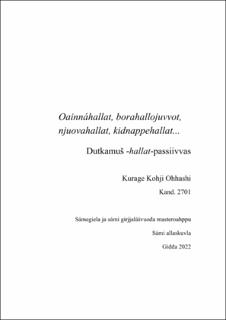Oainnáhallat, borahallojuvvot, njuovahallat, kidnappehallat... : Dutkamuš -hallat-passiivvas
Master thesis
Published version
Permanent lenke
https://hdl.handle.net/11250/3015196Utgivelsesdato
2022Metadata
Vis full innførselSamlinger
Sammendrag
Davvisámegielas leat iešguđetlágan passiivašlájat. Okta dain passiivašlájain lea passiiva mas lea -hallat-suorggis (gohčoduvvo adversatiiva passiivan). Dan passiivvas (mun gohčodan dan -hallat-passiivan dán čállosis) lea malefaktiiva mearkkašupmi. Giellaarenain oidnojit ja gullojit muhtun earálágan -hallat-passiivvat. Dán masterbarggus lean dutkan, man muddui informánttat dohkkehedje iešguđetlágan -hallat-passiivvaid davvisámegielas. Ovddeš giellaoahpain oidnojit muhtun -hallat-passiivva govvádusat, muhto eai čilgejuvvon nu dárkilit. Mu dutkanbarggu ulbmil lei loktet -hallat-passiivva dutkansuorgin bajás ja dárkileappot gávdnat -hallat-passiivva govvádusa. Mu dutkansuorgi lea morfologiija, semántihkka ja neologisma. Lean bargan kvantitatiiva metodain Ártegis cealkagat-nammasaš jearrahallanskoviin, mainna lean iskkadan vuđolaččat semánttalaš, morfologalaš ja neologisttalaš áššiid. Jearahallanskovvi sisttisdoallá -hallat-passiivva sihke prototypalaš ja eahpeprototyhpalaš cealkagiid ja lean dutkan dainna, man muddui leat dohkkehuvvon iešguđetlágan -hallat-passiivacealkagat. Lean guorahallan materiálaid informánttaid agiid, bajásšaddanbáikkiid, mánnávuođa skuvlaáiggi dehálamos gielaid, beaivválaš giellaanu mielde.
Mu dutkanbarggu bohtosiin oidnojit ollu iešguđetlágan tendeassat juohke cealkagis. Informánttaide orru leame váttis árvvoštallat, leatgo eahpeprototyhpalaš -hallat-passiivvat dohkálaččat. Juohke informántta duogážis lea fas iešguđetge dohkkehantendeansa. Dálá davvisámegielas lea ain -hallat-passiiva, muhto malefaktiivavuohta orru muhtun muddui jávkame dálá davvisámegiela -hallat-passiivvas. Neologisma geahččanguovllus oidnojit muhtunlágan tendeanssat iešguđege informánttaid duogážiid gaskkas, vaikko -hallat-passiiva ii oro leame nu produktiiva. Northern Sámi language has several kinds of passive structures. One of the passive structures is the so-called adversative passive (which I call in this paper this -hallat-passive), which has a malefactive meaning. In language domains we can sometimes hear and see some different types of -hallat-passive. In this master thesis I have researched how much various types of -hallat-passive of the Norther Sámi language can be accepted. In previous grammars we can find some descriptions about -hallat-passive, but they are not sufficiently explained. The main goal of my research has been to try to focus on the -hallat-passive as a research topic and to find more accurate descriptions of the -hallat-passive and my research fields are mainly on semantics, morphology and neologism. I have studied using a paper-based and digital survey and in my survey I’ve asked informants to estimate several sentences of prototypical and unprototypical examples of -hallat-passive and for each sentence they answered how well they could accept the sentence of -hallat-passive.
As a result of my research it can be seen that there are several kinds of tendencies in each sentence. It seems difficult for informants to judge whether unprototypical -hallat-passives are acceptable or not. For informants of different backgrounds one can also see different tendencies of acceptation. In the modern northern Sámi language we still have the -hallat-passive, however, malefactiveness seems to some degree be missing from the modern northern Sámi language. In the neological perspective we can see several tendencies among informants of different bachgrounds, even though -hallat-passive doesn't seem so productive.
